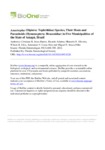Use este identificador para citar ou linkar para este item:
http://www.alice.cnptia.embrapa.br/alice/handle/doc/953875Registro completo de metadados
| Campo DC | Valor | Idioma |
|---|---|---|
| dc.contributor.author | BARROS, C. R. de J. | pt_BR |
| dc.contributor.author | ADAIME, R. | pt_BR |
| dc.contributor.author | OLIVEIRA, M. N. | pt_BR |
| dc.contributor.author | SILVA, W. R. | pt_BR |
| dc.contributor.author | COSTA NETO, S. V. | pt_BR |
| dc.contributor.author | SOUZA FILHO, M. F. | pt_BR |
| dc.date.accessioned | 2013-03-22T11:11:11Z | pt_BR |
| dc.date.available | 2013-03-22T11:11:11Z | pt_BR |
| dc.date.created | 2013-03-22 | pt_BR |
| dc.date.issued | 2012 | pt_BR |
| dc.identifier.citation | Florida Entomologist, Florida, v. 95, n. 3, p. 694-705, Sep. 2012. | pt_BR |
| dc.identifier.uri | http://www.alice.cnptia.embrapa.br/alice/handle/doc/953875 | pt_BR |
| dc.description | A total of 817 samples (1,094.36 kg) of potential fruit fly (Diptera:Tephritidae) hosts were collected from 70 plant species across 29 families in the state of Amapá, Brazil. Twenty-three of these plant species were infested with tephritid larvae. Twelve species of Anastrepha were recovered in different proportions: Anastrepha striata (82.65%), Anastrepha coronilli (6.63%), Anastrepha obliqua (5.47%), Anastrepha distincta (2.28%), Anastrepha fraterculus (2.10%), Anastrepha parishi (0.30%), Anastrepha leptozona (0.22%), Anastrepha pickeli (0.11%), Anastrepha antunesi (0.07%), Anastrepha serpentina (0.07%), Anastrepha sororcula (0.06%), and Anastrepha zenildae (0.04%). Anastrepha striata was recorded from the greatest number of hosts (14 plant species in 8 families). The periods of occurrence of different Anastrepha species were variable, but we observed that A. striata was constantly present in Psidium guajava and sporadically present in fruits of other hosts. The fruits of wild plant species showed the highest rates of infestation by fruit flies with Pouteria sp.1 presenting a rate of (434.29 puparia/kg), followed by Manihot sp. (130.43 puparia/kg) and Inga sp.5 (120.62 puparia/kg). All of parasitoids recovered from collection of infested fruit were Braconidae: Doryctobracon areolatus (95.86%), Opius bellus (2.76%), Asobara anastrephae (1.07%), and Utetes anastrephae (0.31%). The highest percentage of parasitism (8.45%) was observed in samples of Spondias mombin. | pt_BR |
| dc.language.iso | eng | eng |
| dc.rights | openAccess | eng |
| dc.subject | Hospedeiro silvestre | pt_BR |
| dc.subject | Parasito nativo | pt_BR |
| dc.subject | Fruit fly | pt_BR |
| dc.subject | Wild hosts | pt_BR |
| dc.subject | Native parasitoid | pt_BR |
| dc.subject | Mosca-das-frutas | pt_BR |
| dc.title | Anastrepha (Diptera: Tephritidae) species, their hosts and parasitoids (Hymenoptera: Braconidae) in five municipalities of the State of Amapá, Brazil. | pt_BR |
| dc.type | Artigo de periódico | pt_BR |
| dc.date.updated | 2017-05-29T11:11:11Z | pt_BR |
| dc.subject.thesagro | Hospedeiro vegetal | pt_BR |
| dc.subject.nalthesaurus | Anastrepha striata | pt_BR |
| dc.subject.nalthesaurus | Amazonia | pt_BR |
| riaa.ainfo.id | 953875 | pt_BR |
| riaa.ainfo.lastupdate | 2017-05-29 | pt_BR |
| dc.contributor.institution | CRISTIANE RAMOS DE JESUS BARROS, CPAF-AP; RICARDO ADAIME DA SILVA, CPAF-AP; MANOELA N. OLIVEIRA, Universidade Federal do Amapá; WILSON R. SILVA, Secretaria de Estado da Educação do Amapá; SALUSTIANO VILAR COSTA NETO, IEPA; MIGUEL F. SOUZA-FILHO, Instituto Biológico. | pt_BR |
| Aparece nas coleções: | Artigo em periódico indexado (CPAF-AP)  | |
Arquivos associados a este item:
| Arquivo | Descrição | Tamanho | Formato | |
|---|---|---|---|---|
| AP2013Anastrephaspeciesofamapa.pdf | 225,61 kB | Adobe PDF |  Visualizar/Abrir |









